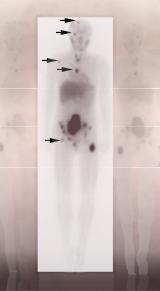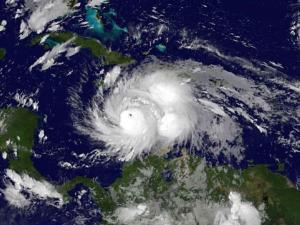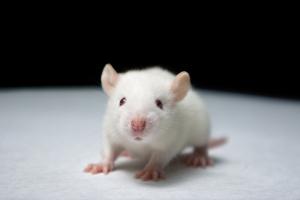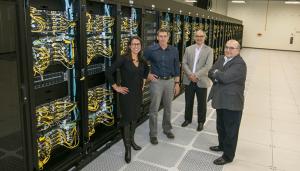LAB REPORT
Science and Technology Making Headlines
Oct. 21, 2016


Lawrence Livermore National Laboratory researchers have demonstrated for the first time how an asteroid or comet could have caused the mega crater on Phobos without completely destroying the Martian moon.
A death star is born
New simulations have revealed the massive impact that may have created our solar system’s own “Death Star.”
A bizarre 5.6-mile-wide crater marring the surface of Mars’ largest moon, Phobos, has long baffled scientists, with many noting its physical resemblance to the fictional-planet destroyer in the "Star Wars" films.
Now, Lawrence Livermore researchers have found numerous scenarios that could have created the feature without entirely destroying Phobos, including an asteroid or comet roughly 250 meters across slamming into the moon at nearly 4 miles per second.


Image of neuroblastoma using the radiopharmaceutical metaiodobenzylguanidine. The arrows identify areas of drug uptake to identify metastatic tumors.
It’s in the genes
Lawrence Livermore scientists and collaborators have developed a new technique to measure radiation dose levels using gene expression analysis of whole blood from cancer patients receiving targeted radiation therapy.
There are unique challenges to estimate the internal dose after radiotherapy is administered. The current practice of calculating internal radiation dose is done by either bioassay (such as urine or fecal samples) or by using biokinetic models to estimate radioactivity as provided by the Committee on Medical Internal Radiation Dose (MIRD).
Radiotherapy is a therapy using ionizing radiation, generally as part of cancer treatment to control or kill malignant cells. Radiation therapy may be beneficial in a number of cancer types if these cancers are localized to one area of the body. It also may be used to prevent tumor recurrence after surgery upon removal of a primary malignant tumor.


Hurricane Matthew grew from a tropical storm to a Category 5 hurricane.
Every storm is a climate change storm
Hurricane Matthew shocked storm-watchers lwhen it gained energy and grew from a tropical storm to a Category 5 hurricane so quickly that it shattered records.
But thanks to climate change, storms like Matthew are becoming more and more severe.
As human activity has warmed the planet, scientists at the Lawrence Livermore National Laboratory point out that the oceans have dramatically warmed over the last century because "the ocean absorbs more than 90 percent of the Earth's excess heat increase that is associated with global warming. The observed ocean and atmosphere warming is a result of continuing greenhouse gas emissions."
A warmer ocean and a warmer atmosphere means there's more energy in the ocean and more energy in the atmosphere, and more energy in the ocean and in the atmosphere means more fuel for smaller tropical depressions to quickly grow into powerful superstorms, such as Matthew.


New research by Lawrence Livermore researchers could lead to the end of animal testing in the laboratory.
Saying bye bye to animal testing
Medical and research testing on laboratory animals for human safety may soon no longer be necessary.
A team of scientists and engineers at Lawrence Livermore National Laboratory is developing the in-vitro Chip-based Human Investigational Platform (iCHIP), which can replicate the central nervous system (brain), peripheral nervous system, the blood-brain barrier and the heart -- the basic four biological systems required for life.
As LLNL engineer Dave Soscia, co-lead on the project, which they call "human-on-a-chip," explains: "It's a testing platform for exposure to agents whose effects are unknown to humans. If you have a system that is engineered to more closely replicate the human environment, you can skip over the really lengthy process of animal testing, which doesn't necessarily give us information relevant to humans."


LLNL and Norway researchers are working to improve cervical cancer screening though the use of supercomputers.
The supercomputing of cancer screening
Lawrence Livermore and Norwegian researchers are collaborating to apply high performance computing (HPC) to the analysis of medical data to improve screening for cervical cancer.
The convergence of high performance computing, big data and life science is enabling the development of personalized medicine, says Ghaleb Abdulla, Livermore lead on the collaboration with Norway and director of LLNL’s Institute for Scientific Computing Research. “Delivering care tailored to the needs of the individual, rather than population averages, has the potential to transform the delivery of healthcare.”
Abdulla’s team is partnering with the Cancer Registry of Norway “to advance precision medicine” by developing individually tailored prevention and treatment strategies. The partnership’s ultimate goal is to improve the outcome of women affected by cervical and breast cancers.





